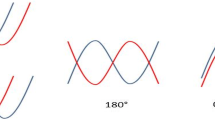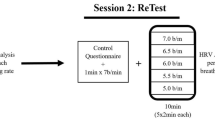Abstract
We developed a simple method for identifying resonance frequency by focusing on the spectral peak of the low-frequency (LF) component of heart rate variability (HRV) and examined the hypothesis that paced breathing at an accurate resonance frequency increases HRV and baroreflex sensitivity (BRS). We assessed a peak frequency of the LF component of the resting HRV by using power spectral analysis under respiratory control at 0.25 Hz, and a resonance frequency, which was evaluated by using the standard breathing maneuver (Lehrer 2007). We examined the effects of paced breathing at the peak frequency of the LF component (Spectral condition) and paced breathing at the resonance frequency as determined by the standard breathing maneuver (Standard condition) on HRV and BRS in 28 healthy college students and young adults. Electrocardiogram, respiration, and noninvasive continuous blood pressure was recorded during a 5-min baseline, followed by a 5-min paced breathing session. Results indicated that the BRS increased during the breathing session under both conditions, but the increase in BRS under the Spectral condition was higher than the Standard condition (p < .05). The LF amplitude increased during the breathing session under both conditions (p < .001), although the difference between the conditions was not significant. These results suggest that paced breathing at the peak frequency of the LF component enhanced the autonomic baroreflex function. Moreover, assessment of the LF-peak may provide more accurate information on resonance frequency for paced breathing during HRV biofeedback.


Similar content being viewed by others
References
Berntson, G. G., Bigger, J. T., Jr., Eckberg, D. L., Grossman, P., Kaufmann, P. G., Malik, M., et al. (1997). Heart rate variability: Origins, methods, and interpretive caveats. Psychophysiology,34(6), 623–648. https://doi.org/10.1111/j.1469-8986.1997.tb02140.x.
Bueche, F. (1972). Wave motion. In F. Bouche (Ed.), Principles of physics (2nd ed., pp. 292–293). Tokyo: McGraw-Hill Kogakusha.
Cowan, M. J., Pike, K. C., & Budzynski, H. K. (2001). Psychosocial nursing therapy following sudden cardiac arrest: Impact on two-year survival. Nursing Research,50(2), 68–76. https://doi.org/10.1097/00006199-200103000-00002.
DeBoer, R. W., Karemaker, J. M., & Strackee, J. (1987). Hemodynamic fluctuations and baroreflex sensitivity in humans: A beat-to-beat model. American Journal of Physiology, Heart and Circulatory Physiology,253(3), H680–H689. https://doi.org/10.1152/ajpheart.1987.253.3.H680.
Del Pozo, J. M., Gevirtz, R. N., Scher, B., & Guarneri, E. (2004). Biofeedback treatment increases heart rate variability in patients with known coronary artery disease. American Heart Journal,147(3), 545. https://doi.org/10.1016/j.ahj.2003.08.013.
Duschek, S., Wörsching, J., & Reyes Del Paso, G. A. (2013). Interactions between autonomic cardiovascular regulation and cortical activity: A CNV study. Psychophysiology,50(4), 388–397. https://doi.org/10.1111/psyp.12026.
Fortin, J., Wellisch, A., & Maier, K. (2013). CNAP—Evolution of continuous non-invasive arterial blood pressure monitoring. Biomedizinische Technik. https://doi.org/10.1515/bmt-2013-4179.
Hassett, A. L., Radvanski, D. C., Vaschillo, E. G., Vaschillo, B., Sigal, L. H., Karavidas, M. K., et al. (2007). A pilot study of the efficacy of heart rate variability (HRV) biofeedback in patients with fibromyalgia. Applied Psychophysiology and Biofeedback,32(1), 1–10. https://doi.org/10.1007/s10484-006-9028-0.
Hayano, J., Barros, A. K., Kamiya, A., Ohte, N., & Yasuma, F. (2005). Assessment of pulse rate variability by the method of pulse frequency demodulation. BioMedical Engineering OnLine,4, 62. https://doi.org/10.1186/1475-925X-4-62.
Hayano, J., Mukai, S., Sakakibara, M., Okada, A., Takata, K., & Fujinami, T. (1994). Effects of respiratory interval on vagal modulation of heart rate. American Journal of Physiology-Heart and Circulatory Physiology,267(1), H33–H40. https://doi.org/10.1152/ajpheart.1994.267.1.H33.
Hirsch, J. A., & Bishop, B. (1981). Respiratory sinus arrhythmia in humans: How breathing pattern modulates heart rate. American Journal of Physiology-Heart and Circulatory Physiology,241(4), H620–H629. https://doi.org/10.1152/ajpheart.1981.241.4.H620.
Jagadeesh, A. M., Singh, N. G., & Mahankali, S. (2012). A comparison of a continuous noninvasive arterial pressure (CNAP™) monitor with an invasive arterial blood pressure monitor in the cardiac surgical ICU. Annals of Cardiac Anaesthesia,15, 180–184. https://doi.org/10.4103/0971-9784.97973.
Jeleazcov, C., Krajinovic, L., Münster, T., Birkholz, T., Fried, R., Schüttler, J., et al. (2010). Precision and accuracy of a new device (CNAP™) for continuous non-invasive arterial pressure monitoring: assessment during general anaesthesia. British Journal of Anaesthesia,105, 264–272. https://doi.org/10.1093/bja/aeq143.
Karavidas, M. K., Lehrer, P. M., Vaschillo, E., Vaschillo, B., Marin, H., Buyske, S., et al. (2007). Preliminary results of an open label study of heart rate variability biofeedback for the treatment of major depression. Applied Psychophysiology and Biofeedback,32(1), 19–30. https://doi.org/10.1007/s10484-006-9029-z.
Kornet, L., Hoeks, A. P., Janssen, B. J., Houben, A. J., De Leeuw, P. W., & Reneman, R. S. (2005). Neural activity of the cardiac baroreflex decreases with age in normotensive and hypertensive subjects. Journal of Hypertension,23(4), 815–823. https://doi.org/10.1097/01.hjh.0000163151.50825.e2.
La Rovere, M. T., Bigger, J. T., Jr., Marcus, F. I., Mortara, A., & Schwartz, P. J. (1998). Baroreflex sensitivity and heart-rate variability in prediction of total cardiac mortality after myocardial infarction. ATRAMI (Autonomic Tone and Reflexes After Myocardial Infarction) Investigators. Lancet,351(9101), 478–484. https://doi.org/10.1016/s0140-6736(97)11144-8.
Lehrer, P. M. (2007). Biofeedback training to increase heart rate variability. In P. M. Lehrer, R. L. Woolfolk, & W. E. Sime (Eds.), Principles and practice of stress management (pp. 227–248). New York: The Guilford Press.
Lehrer, P. M., Vaschillo, E., Vaschillo, B., Lu, S. E., Eckberg, D. L., Edelberg, R., et al. (2003). Heart rate variability biofeedback increases baroreflex gain and peak expiratory flow. Psychosomatic Medicine,65(5), 796–805. https://doi.org/10.1097/01.PSY.0000089200.81962.19.
Lehrer, P. M., Vaschillo, E., Vaschillo, B., Lu, S. E., Scardella, A., Siddique, M., et al. (2004). Biofeedback treatment for asthma. Chest,126(2), 352–361. https://doi.org/10.1378/chest.126.2.352.
Lehrer, P., Vaschillo, B., Zucker, T., Graves, J., Katsamanis, M., Aviles, M., et al. (2013). Protocol for heart rate variability biofeedback training. Biofeedback,41(3), 98–109. https://doi.org/10.5298/1081-5937-41.3.08.
Madwed, J. B., Albrecht, P., Mark, R. G., & Cohen, R. J. (1989). Low-frequency oscillations in arterial pressure and heart rate, a simple computer model. American Journal of Physiology-Heart and Circulatory Physiology,256(6), H1573–H1579.
McCray, R., Atkinson, M., & Tomasino, D. (2003). Impact of a workplace stress reduction program on blood pressure and emotional health in hypertensive employees. Journal of Alternative and Complementary Medicine,9(3), 355–369. https://doi.org/10.1089/107555303765551589.
Nolan, R. P., Kamath, M. V., Floras, J. S., Stanley, J., Pang, C., Picton, P., et al. (2005). Heart rate variability biofeedback as a behavioral neurocardiac intervention to enhance vagal heart rate control. American Heart Journal,149(6), 1137.e1–1137.e7. https://doi.org/10.1016/j.ahj.2005.03.015.
Parlow, J., Viale, J. P., Annat, G., Hughson, R., & Quintin, L. (1995). Spontaneous cardiac baroreflex in humans: Comparison with drug-induced responses. Hypertension,25(5), 1058–1068. https://doi.org/10.1161/01.HYP.25.5.1058.
Peňáz, J. (1973). Photoelectric Measurement of blood pressure, volume and flow in the finger. Digest of the 10th international conference on medical and biological engineering, Dresden, p. 104.
Sakakibara, M., & Oikawa, O. (2016). Identifying resonance frequency in heart rate variability biofeedback: An examination of simple procedure using LF peak frequency during resting state. Japanese Journal of Biofeedback Research,44(1), 21–28. https://doi.org/10.20595/jjbf.44.1_21.
Sakakibara, M., Teramoto, Y., & Tani, I. (2014). Development of a short-form self-report measure to assess relaxation effects. Japanese Journal of Psychology,85(3), 284–293. https://doi.org/10.4992/jjpsy.85.13210.
Task Force of the European Society of Cardiology and the North American Society of Pacing and Electrophysiology. (1996). Heart rate variability: Standards of measurement, physiological interpretation, and clinical use. European Heart Journal,17(3), 354–381.
van de Vooren, H., Gademan, M. G., Swenne, C. A., TenVoorde, B. J., Schalij, M. J., & Van der Wall, E. E. (2007). Baroreflex sensitivity, blood pressure buffering, and resonance: what are the links? Computer simulation of healthy subjects and heart failure patients. Journal of Applied Physiology,102(4), 1348–1356. https://doi.org/10.1152/japplphysiol.00158.2006.
Vaschillo, E., Lehrer, P., Rishe, N., & Konstantinov, M. (2002). Heart rate variability biofeedback as a method for assessing baroreflex function: A preliminary study of resonance in the cardiovascular system. Applied Psychophysiology and Biofeedback,27(1), 1–27. https://doi.org/10.1023/A:1014587304314.
Vaschillo, E. G., Vaschillo, B., & Lehrer, P. M. (2006). Characteristics of resonance in heart rate variability stimulated by biofeedback. Applied Psychophysiology and Biofeedback,31(2), 129–142. https://doi.org/10.1007/s10484-006-9009-3.
Vaschillo, E. G., Vaschillo, B., Pandina, R. J., & Bates, M. E. (2011). Resonances in the cardiovascular system caused by rhythmical muscle tension. Psychophysiology,48(7), 927–936. https://doi.org/10.1111/j.1469-8986.2010.01156.x.
Yeragani, V. K., Sobolewski, E., Kay, J., Jampala, V. C., & Igel, G. (1997). Effect of age on long-term heart rate variability. Cardiovascular Research,35(1), 35–42. https://doi.org/10.1016/S0008-6363(97)00107-7.
Yucha, C. B., Tsai, P. S., Calderon, K. S., & Tian, L. (2005). Biofeedback-assisted relaxation training for essential hypertension: Who is most likely to benefit? Journal of Cardiovascular Nursing,20(3), 198–205. https://doi.org/10.1097/00005082-200505000-00012.
Zucker, T. L., Samuelson, K. W., Muench, F., Greenberg, M. A., & Gevirtz, R. N. (2009). The effects of respiratory sinus arrhythmia biofeedback on heart rate variability and posttraumatic stress disorder symptoms: A pilot study. Applied Psychophysiology and Biofeedback,34(2), 135–143. https://doi.org/10.1007/s10484-009-9085-2.
Acknowledgements
This study was supported by JSPS KAKENHI Grant Number 16K04395. The authors are grateful to Dr. Junichiro Hayano (Nagoya City University Graduate School of Medical Sciences), and Professor Gregory L. Rohe (Aichi Gakuin University) for their assistance in editing this manuscript.
Author information
Authors and Affiliations
Corresponding author
Ethics declarations
Conflict of interest
The authors declare that they have no conflicts of interest.
Ethical Approval
The study was approved by the Research Ethics Committee of Aichi Gakuin University (No. 16-02). Informed consent was obtained from all individual participants included in the study.
Additional information
Publisher's Note
Springer Nature remains neutral with regard to jurisdictional claims in published maps and institutional affiliations.
Rights and permissions
About this article
Cite this article
Sakakibara, M., Kaneda, M. & Oikawa, L.O. Efficacy of Paced Breathing at the Low-frequency Peak on Heart Rate Variability and Baroreflex Sensitivity. Appl Psychophysiol Biofeedback 45, 31–37 (2020). https://doi.org/10.1007/s10484-019-09453-z
Published:
Issue Date:
DOI: https://doi.org/10.1007/s10484-019-09453-z




